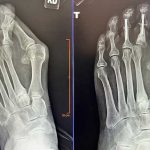
Both the podiatrist and orthopedic foot and ankle specialist at OrthoConnecticut are highly qualified, board-certified doctors with different training, expertise, and focus.
A podiatrist is a doctor of podiatric medicine (DPM) and treats the bones, soft tissues, and joints of the foot and ankle, as well as skin conditions and mechanics of the foot/ankle. A podiatrist may also train in certain surgical techniques. A podiatrist frequently treats conditions such as corns, calluses, blisters, heel pain and spurs, bunions, fallen arches, hammer toe, biomechanical gait issues, nail disorders, warts, chronic wounds from diabetes, and other infections.
A Foot and Ankle Orthopedic Surgeon is a fellowship-trained, board-certified Doctor of Medicine (MD) who can expertly diagnose, treat, and rehab injuries and diseases of the musculoskeletal system that affect muscles, bones, ligaments, tendons, and other connective tissues of the foot and ankle. This type of surgeon also addresses musculoskeletal issues of the foot and ankle that impact the rest of the body. Conditions you might see an orthopedic foot and ankle specialist for include fractures, sprains and strains, ligament tears, arthritis, tendonitis, deformities, and complex foot and ankle trauma, dislocations, and reconstruction. A foot and ankle orthopedic surgeon performs complex surgical procedures, not performed by a podiatrist.
There can be some overlap in what a podiatrist treats and what an orthopedic foot and ankle specialist treats such as the simpler conditions of sprains and strains. Both a podiatrist and orthopedic foot and ankle specialist use non-surgical techniques like bracing, injectable treatments, physical therapy, and orthotics, as well as surgical treatments as needed to get you on the road to feeling better.
Is it better to see a podiatrist or orthopedist?
At OrthoConnecticut our Foot and Ankle Center includes both a podiatrist and attending orthopedic foot and ankle specialist. Whether to see a podiatrist or an orthopedist can be confusing because there are more commonalities than differences between them. An orthopedist treats areas of the musculoskeletal bone, joint, and connective tissue issues of the body including the foot and ankle, but also beyond such as knees, hips, and spine. A podiatrist specializes in the foot and ankle, the skin, blood vessels and associated nerves. If you are unsure which type of doctor to see, you can call OrthoConnecticut and describe your pain or issue and we will confirm whether to see a podiatrist or an orthopedist and work to get you the help you need quickly.
What procedures does a podiatrist do?
An OrthoConnecticut podiatrist frequently treats surgical and nonsurgical conditions that affect the foot and ankle. Some chronic conditions that are frequently treated include corns, calluses, heel spurs, bunions, fallen arches, hammer toes, flat feet, biomechanical gait issues, arthritis, nail disorders, sprains and strains, fractures and sports-related injuries, plantar fasciitis, Achilles tendonitis, Morton’s neuroma, chronic wounds from diabetes, and other infections. Also, a podiatrist will fit you for corrective orthotics and ankle braces and can address issues surgically, as needed. Learn more about what a podiatrist does »
When to see a podiatrist for foot pain
If you have foot pain or injury you should be seen quickly by a podiatrist particularly if you have severe pain or swelling for one or two days. If your feet hurt, a podiatrist can help diagnose the reason for the pain, can prescribe orthotics or the best kind of shoes for you, as well as treat the cause of your pain both non-surgically or surgically, if needed. The board-certified podiatrist at OrthoConnecticut's Foot and Ankle Center can diagnose the reason for your foot pain and can help you feel better.
How to prevent ankle injuries
There are several ways to prevent ankle injuries including wearing the right supportive footwear for the activity and a well-fitting shoe. Taping, strapping, or bracing the ankle can provide additional joint support as can working on ankle strength, flexibility, and developing good balance. If you are exercising be sure to warm up first and avoid uneven ground when walking or running to help prevent an ankle injury. If you need help determining how to support and strengthen your ankle, or what type of shoe, orthotic, or ankle brace might be best for you to prevent an ankle injury, OrthoConnecticut's Foot and Ankle Surgeon, Dr. Randolph Sealey, can help advise you.



















